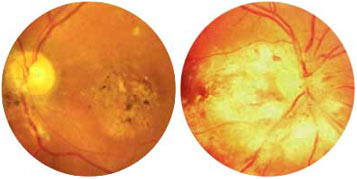Cytomegalovirus
Eye Care > Diseases of the Eye > Cytomegalovirus
What is Cytomegalovirus?

Photographs of retinas affected with CMV retinitis.

Normal (unaffected) retina
CMV is the most common type of virus that infects those who are HIV positive. It affects the eye in about 30% of the cases by causing damage to the retina. This is called CMV retinitis. The likelihood of developing CMV retinitis increases as the CD4 cell count decreases.
CMV retinitis may affect one eye at first, but usually progresses to both eyes and becomes worse as the patient’s ability to fight infection decreases. The virus is sight threatening and usually requires the care and treatment of a vitreo-retinal surgeon. Patients with CMV retinitis are at risk of retinal detachment, haemorrhages, and inflammation of the retina that can lead to permanent loss of vision and even blindness.
Signs and Symptoms
CMV retinitis usually causes symptoms, but not always.Patients with a condition that suppresses the immune system should watch for the following eye symptoms while under the care of a physician.
- Floaters (spots, bugs, spider webs)
- Light flashes
- Blind spots
- Blurred vision
- Obstructed areas of vision
- Sudden decrease of vision
Detection and Diagnosis
Most patients with CMV retinitis are referred for eye treatment by another physician. The vitreo-retinal surgeon diagnoses CMV retinitis by thoroughly examining the back of the eye using ophthalmoscopy. Fluorescein angiography may be needed to evaluate the circulatory system of the retina.
Treatment
When managing CMV retinitis, the doctor’s goal is to slow the progression of the disease and to treat related eye problems. Anti-viral medications such as ganciclovir or foscarnet are often prescribed. These drugs can be administered orally, intravenously, injected directly into the eye or through an intravitreal implant.
Illustrations by Mark Erickson
With acknowledgement to St. Lukes Eye Hospital.
